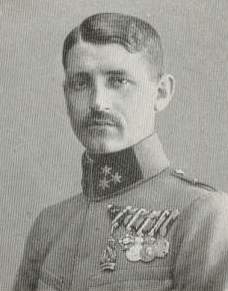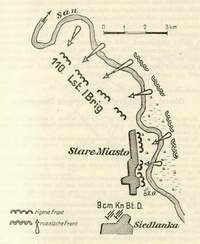Georg Dragičević
 Georg
Dragičević was born on November 7th 1890 in Kalesija in Bosnia the son of a
Gendarmerie District Sergeant. He commenced his military career by attending the
Technical Military Academy at Mödling near Vienna and graduated from there as a
Leutnant on the18th August 1911 with an assignment to Festungsartillerieregiment
Kaiser Nr.1 (Fortress Artillery) then based in Vienna. On mobilisation in August
1914 he was promoted to Oberleutnant and given command of a battery in the106th
Field Artillery Brigade equipped with obsolete 9-centimetre field guns. This
brigade was part of the 106th Landsturm Infantry Division commanded by
Feldmarschalleutnant Ernst Kletter and although nominally
a reserve formation it proved to be a very effective fighting formation with a
well earned reputation for steadiness and reliability throughout the war.
Georg
Dragičević was born on November 7th 1890 in Kalesija in Bosnia the son of a
Gendarmerie District Sergeant. He commenced his military career by attending the
Technical Military Academy at Mödling near Vienna and graduated from there as a
Leutnant on the18th August 1911 with an assignment to Festungsartillerieregiment
Kaiser Nr.1 (Fortress Artillery) then based in Vienna. On mobilisation in August
1914 he was promoted to Oberleutnant and given command of a battery in the106th
Field Artillery Brigade equipped with obsolete 9-centimetre field guns. This
brigade was part of the 106th Landsturm Infantry Division commanded by
Feldmarschalleutnant Ernst Kletter and although nominally
a reserve formation it proved to be a very effective fighting formation with a
well earned reputation for steadiness and reliability throughout the war.
As a part of Archduke Joseph Ferdinand's 4th Army with further
subordination to Feldmarschalleutnant Rudolf Králiček's IX. Corps, the division
took part in the May 1915 Gorlice-Tarnów offensive in Southern Poland. The
attack commenced at 1000 hours on the 2nd May with the division jumping off from
positions just North of Gromnik. Advancing East on the North bank of the Biała
river the division captured Tuchów on the 3rd, Wielopole on the 10th and
by the14th was on the San river in the vicinity of Stare Miasto 35 kilometres
downstream from Jaroslau. The division would be involved in heavy fighting on
the San for the next three weeks before the advance could continue. On the15th
of May Oberleutnant
Dragičević was commanding two batteries of 9-centimetre field guns in
support of Generalmajor Adolf Aust's 110th Landsturm Infantry Brigade at Stare Miasto. Due to
insufficient bridging material or pontoons, the brigade had to satisfy itself
with the occupation of the Eastern perimeter of the village. Positioned two kilometres to
the South at the village of Siedlanka were the ten field pieces under the command of
Oberleutnant
Dragičević.
 At
dawn on the 19th May, the Russians crossed the San from the meadows opposite and
attacked along the entire front of the110. LstIBrigade. Initially
Dragičević permitted one battery to open fire and set out towards the
brick kiln* between the Southern exit of Stare Miasto and the river, which by
then was only a hundred paces from the enemy firing line. Faced with this
immediate threat the forward artillery observer already in place had descended
the chimney of the brick works in order to choose another observation post.
Dragičević however climbed up the 36 metre chimney in his place and
steadfastly controlled the fire of his batteries from dawn until midday under
Russian fire through the flue of the chimney. The effect of this fire to the
flanks of the enemy infantry and to his bridge building activity was such, that
the attack came to a halt. Noticeable was the reduced fighting spirit of the
Russians as they became anxious about being cut off and when the only connection to
the opposite bank remained through the few undamaged pontoon
boats, the enemy commander gave the order to withdraw. This withdrawal however
could not prevent the capture of an entire Siberian infantry regiment with 10
officers and about 2000 NCOs and men when an attack by the divisional reserve in
the afternoon brought the battle to a close. The part of Oberleutnant
Dragičević in no small way played an highly significant role in this
success and he was justifiably awarded the Military Maria Theresa Order.
At
dawn on the 19th May, the Russians crossed the San from the meadows opposite and
attacked along the entire front of the110. LstIBrigade. Initially
Dragičević permitted one battery to open fire and set out towards the
brick kiln* between the Southern exit of Stare Miasto and the river, which by
then was only a hundred paces from the enemy firing line. Faced with this
immediate threat the forward artillery observer already in place had descended
the chimney of the brick works in order to choose another observation post.
Dragičević however climbed up the 36 metre chimney in his place and
steadfastly controlled the fire of his batteries from dawn until midday under
Russian fire through the flue of the chimney. The effect of this fire to the
flanks of the enemy infantry and to his bridge building activity was such, that
the attack came to a halt. Noticeable was the reduced fighting spirit of the
Russians as they became anxious about being cut off and when the only connection to
the opposite bank remained through the few undamaged pontoon
boats, the enemy commander gave the order to withdraw. This withdrawal however
could not prevent the capture of an entire Siberian infantry regiment with 10
officers and about 2000 NCOs and men when an attack by the divisional reserve in
the afternoon brought the battle to a close. The part of Oberleutnant
Dragičević in no small way played an highly significant role in this
success and he was justifiably awarded the Military Maria Theresa Order.
Dragičević saw further service as an Adjutant and battery commander on
the Italian front. Promoted to captain on the 1st of November 1917 his final wartime posting was
with the staff of
the Artillery Cadet School in Traiskirchen South of Vienna. Following the
monarchy's collapse he returned to the new state of Yugoslavia where he joined
the armed forces of that country. Becoming a colonel he rose to become the
second in command of the anti-aircraft service of the Royal Yugoslavian Army.
Following Croatia's declaration of independence on 10th April 1941 he joined the
Croatian army in the rank of a general officer. He served as head of the Army
Artillery service in the Croatian Armed Forces Ministry from 1941-1944 followed
by an assignment to the Croatian Embassy in Berlin as head of the military
procurement office. Captured at the wars end by the Soviets, General Dragičević
was not
released from captivity until 1954 when he made his home in Austria. Among his decorations, he held the order of
the Iron Crown Third Class with War Decoration and Swords, the Military Merit Cross Third Class with War Decoration and Swords, both the Silver (with Swords)
and Bronze Medals for Military Merit (Signum Laudis) and the Karl Troop Cross.
The General died on the 28th of July 1980 in Vienna.
* Shown as Z.O. on the map.
Back to Miscellaneous
Biographies

 Georg
Dragičević was born on November 7th 1890 in Kalesija in Bosnia the son of a
Gendarmerie District Sergeant. He commenced his military career by attending the
Technical Military Academy at Mödling near Vienna and graduated from there as a
Leutnant on the18th August 1911 with an assignment to Festungsartillerieregiment
Kaiser Nr.1 (Fortress Artillery) then based in Vienna. On mobilisation in August
1914 he was promoted to Oberleutnant and given command of a battery in the106th
Field Artillery Brigade equipped with obsolete 9-centimetre field guns. This
brigade was part of the 106th Landsturm Infantry Division commanded by
Feldmarschalleutnant Ernst Kletter and although nominally
a reserve formation it proved to be a very effective fighting formation with a
well earned reputation for steadiness and reliability throughout the war.
Georg
Dragičević was born on November 7th 1890 in Kalesija in Bosnia the son of a
Gendarmerie District Sergeant. He commenced his military career by attending the
Technical Military Academy at Mödling near Vienna and graduated from there as a
Leutnant on the18th August 1911 with an assignment to Festungsartillerieregiment
Kaiser Nr.1 (Fortress Artillery) then based in Vienna. On mobilisation in August
1914 he was promoted to Oberleutnant and given command of a battery in the106th
Field Artillery Brigade equipped with obsolete 9-centimetre field guns. This
brigade was part of the 106th Landsturm Infantry Division commanded by
Feldmarschalleutnant Ernst Kletter and although nominally
a reserve formation it proved to be a very effective fighting formation with a
well earned reputation for steadiness and reliability throughout the war. 